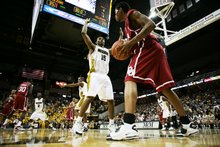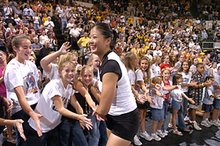You can stop holding your breath, Atch...here's the long-awaited Colorado profile!
2006
To say the least, 2006 was forgettable for the Colorado Buffaloes. Despite having won back-to-back North Division titles in 2004 and 2005, CU was seen as a program in free-fall, especially after a) Gary Barnett stopped recruiting in about 2002, b) they got outscored 112-6 in the ’04 and ’05 Big XII Title Games, and c) Barnett got fired. Dan Hawkins inherited a program that had started to lose its talent and athleticism in the last few years, and it took a while to gain traction. A 19-10 loss to D-1AA (sorry, Division 1 Championship Division) Montana State kick-started an 0-6 start that saw CU play competent defense and incompetent offense. They very nearly upset Georgia in the fourth game of the season, but after a decent showing at Mizzou (a 28-13 loss), they lost at home in 3 OT’s to Baylor (ouch). In the end, a 2-10 season only saw home wins against Texas Tech and Iowa State. They were competitive in many games and improved offensively as the season progressed (well...there was no way to go but up, but they did average 19.3 PPG over the last half of the season after not scoring more than 13 points until Week 6. Dan Hawkins is an offensive-minded coach, and you know things will improve in that regard. But how much? And how soon?
Key Returnees
For a couple years now, it seems CU has been in flux at the skill positions on offense while maintaining steadiness on the O-line (then again, the lingering effects of the utter domination those early-'00s O-lines imposed might just be clouding my memory). Now it’s the opposite. QB Bernard Jackson, RB Hugh Charles, WR’s Alvin Barnett, Patrick Williams, and Dusty Sprague, and stud sophomore TE Riar Geer all return, but the O-line must replace four starters. And to make matters worse, there has been a rash of O-line injuries in spring ball. And did I mention that CU only has about seven scholarship O-linemen?
On the defensive side, CU must replace both starting DE’s and LB Thaddeus Washington, who FINALLY completed his eligibility last year. Their secondary is nice and experienced (somehow CB Terrence Wheatley still has eligibility of his own), and they do return WLB Jordan Dizon (100+ tackles, 11 tackles for loss) and DT Brandon Hypolite (12.5 TFL). It is key that one of the new starting DE’s (Alonzo Barrett? Maurice Lucas?) steps in and gets pressure on the QB in passing situations, otherwise the secondary will be put in pretty tough situations.
As with Baylor, Colorado’s biggest loss is probably in the special teams department. Kicker Mason Crosby, CU’s biggest offensive weapon for the past three years, graduated. Senior Kevin Eberhart has done a decent job in his place, but no other kicker is capable of doing what Crosby did to the ball the last few seasons. They also have a potential weapon as a punt returner—senior Stephone Robinson—but he did next to nothing in that role last season, averaging only 5.1 yards per return.
Spring Developments
Well, the first we heard from Dan Hawkins and Colorado this spring came back on Signing Day, when Hawkins launched into a fantastic rant about pampered athletes and too many practices. Nothing else that could happen in Boulder this spring could top that.
Anyway, QB Bernard Jackson is not a Dan Hawkins-style QB (his best skills are running, running, and juking), so one of the goals of this spring was to find a role for him and still get a QB in place who is more fit for the Hawkins system. Jackson is apparently lining up wide and in the backfield while RSFr. Cody Hawkins and JUCO transfer Nick Nelson battle for prime QB duties. Looking at the numbers, it doesn’t really appear that either has seized the reins just yet. Also, CB Cha’pelle Brown appears to have moved to WR to give the Buffs a deep threat they didn’t really have last year. We’ll see if it works.
Fun With Numbers
As discussed previously, here were the five statistical categories that were most directly related to Colorado’s success/failure last year:
1. Opponents’ Rushing Attempts (0.87)
2. First Down Ratio (0.80)
3. Third Down Conversion Ratio (0.77)
4. Total Plays Ratio (0.71)
5. Opponents’ Total Plays (0.71)
The fact that Opponents’ Rushing Attempts was #1 on this list tells me that opponents were a) able to secure a lead pretty easily and b) content to run the ball, control the clock, and (in theory) pin the Buffs in bad field position because there was no reason to fear Colorado’s offense. If you’re up 14 points against Texas Tech, you know you have to stay aggressive and keep scoring. If you’re up 14 against CU, put it on cruise and make them show you something.
The highly-correlated items on CU’s list here show that ball control was the make-or-break issue for the Buffs in ’06 (and since they went 2-10, there was a lot more break than make). Will they be better at ball control in ’06?
Offensively, there are more weapons at Hawkins’ disposal—Jackson and Brown in particular—but he still has to figure out how to use them all. Hugh Charles shows flashes of unbelievable speed, but he’s every bit as likely to pick the wrong hole as the right one, and he’s been pretty inconsistent throughout his career. However, you figure he will make at least incremental improvement during his senior season, so that will help. But they need to figure out something here—last season, they were pretty much guaranteed 3 points any time they crossed the opponent’s 35. Without Crosby there to bail them out, they’ll need to mount longer drives. And they'll need a strong QB.
Defensively, if they can get some sort of pass rush, their defense should be able to hold up a little better than last year. Dizon is most definitely an All-Big XII-caliber player, and he and Hypolite could be really strong anchors for the front seven. Again, it all comes down to pass rush and pass defense on 3rd downs.
While having unknown quantities on offense might actually help CU in their opening game against CSU, it would behoove the Buffs to get their act together pretty quickly after that since a) the schedule gets tough in a hurry, and b) teams will have CU film at that point and will be better prepared for what's coming. A trip to Tempe to face Arizona State follows the CSU game, and then Florida State comes to Boulder. This team could be much improved from 2006 and still start the season 0-3 (tell me again why this kind of scheduling is a good thing?). The Buffs play their three toughest conference opponents (OU, Nebraska, Missouri) at home, but that might backfire if they can’t pick off at least two wins there. They didn’t win a road game last year, and otherwise winnable games against Baylor, K-State, Iowa State, and Texas Tech get a lot tougher on the road than at home. In all, I do think it's likely that CU shows improvement, but jeez...with this schedule, 6 wins will be difficult to compile. My first impression says somewhere in the neighborhood of 4-8 or 5-7.
Wednesday, April 11, 2007
Colorado Spring Football Preview
Posted by
The Boy
at
6:00 AM
![]()
Subscribe to:
Comment Feed (RSS)






|